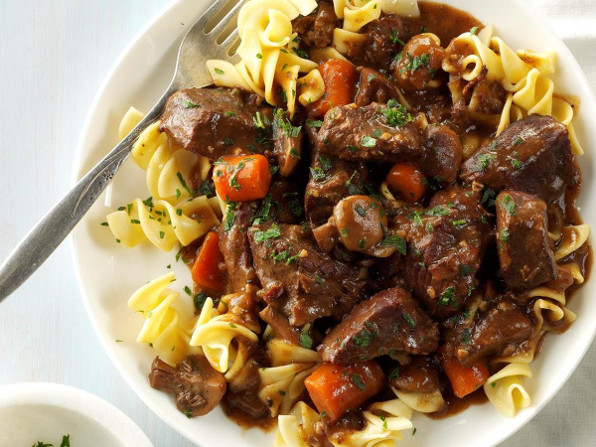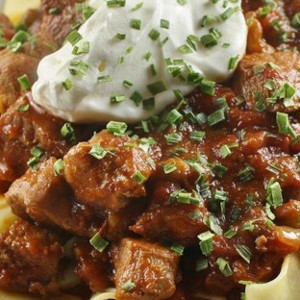It’s nothing new – in fact it’s something very old, and classic in European cuisines. ‘Slow cooking’ has been around for ages and there are good reasons for that. But it’s fallen out of popularity in recent decades for a number of reasons, not the least of which is the quest for convenience…
 Classic slow-simmered Boeuf Bourguignon: More satisfying when cooked
Classic slow-simmered Boeuf Bourguignon: More satisfying when cooked
in a traditional Dutch Oven than in a Slow Cooker…
Call it braising or stewing, or pot roasting or simmering. It’s all ‘slow cooking’ the old fashioned, original way. And the method produces some of the most flavourful, tender and umami-laden dishes you’ve ever tasted. And it fills the house with aromas that will make it hard to concentrate on anything other than when supper is going to be ready.
But why has the method become unpopular?
First and foremost, I think, traditional slow cooking has been set aside as a regular meal prep method by many because it takes time. Some classic recipes call for hours and hours of low-temperature cooking, often accompanied by regular stirring. Many folks today have other priorities and seek the convenience of Fast Food outlets, pre-made and processed foods, and whatever they can stick in the microwave and enjoy in a minimum of minutes. Too bad. Today’s commonplace foods are nowhere near as enjoyable and healthy as the slow cooked gems of yesteryear.
Another reason for the decline in the use of slow cooking techniques has been the evolution of the family from a model where Mom stayed home and looked after the house and Dad went out to win the daily bread, to one in which everyone is out of the house most of the day working or attending school. I wonder if we would need things like video doorbells, which call your smart phone when someone approaches the front porch, if some family member still stayed home all day? Another question for another time – and another blog. The bottom line is, if you’re not home, you can’t keep an eye on the stove or stir the Dutch Oven. And, no, I do not condone leaving a Crock Pot Slow Cooker on all day unattended.
Another factor in the fall from grace of traditional slow cooking has to be the skyrocketing price of energy. Whether you cook with electricity or gas, your energy costs have risen manyfold over the past three decades or so and are still shooting up at an astonishing rate. Mt late step dad, an avid and adventurous cook in his retirement, continually bemoaned the rising cost of energy, saying that, when he had a Turkey or a Ham or a big roast of Beef in the oven, “the little wheels on the electricity meter are probably spinning around like a ceiling fan on a hot summer day.”
Any factors in favour of traditional slow cooking?
Of course. First and foremost, if you like to make your own Red Sauce, as I do, you probably want to make a huge batch when you do and freeze lots of it. I have a 32 (U.S.)qt. / 30 L stock pot I use for simmering bones to make Poultry and Beef Stock, and to simmer Red Sauce. The Stock extraction process can take 3 or 4 hours for Poultry and up to 8 hours for Beef Stock. And my Red Sauce starts with 600 fl. oz. / 17 L of crushed Tomatoes which I simmer down to a thick, rich 13-14 litres of basic Tomato Sauce. You can’t get Stock or Red Sauce like mine in any box, jar or bottle!
And making a big batch of Sauce all at once not only offers you the convenience of having it in the Freezer whenever you want it, but also offers some energy savings over making a small batch every time you need it.
Price-wise, your own home made Stock costs you nothing but the time and energy needed to make it. And, while you can spend $3 – $4 a jar for supermarket Red Sauces, your own home made Sauce comes in at about $1 per quart / Litre. If you eat a lot of Pasta, that’s a real money-saver!
Even though you can make classic dishes like Beouf Bourguinon and Hungarian Goulash in a Slow Cooker, they’re never quite as good the ones you simmer for hours on the stove-top. There’s just something extra about them – a richness – that makes a delicious difference.
Social aspects of traditional Slow Cooking
My step dad had a couple of traditions he insisted on when he was making a slow-cooked meal. One was that everyone had to take part in preparing the ingredients – mainly chopping and cubing – and we all had to take our turn stirring. That made it a true ‘family’ supper. I liked that. And who among us can honestly claim that they don’t have at least one Saturday or Sunday afternoon a week to give to dedicate to such an activity?
Spend less time in front of the screen and more time in front of the stove!
Maggie J.

